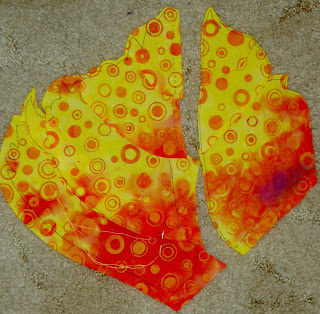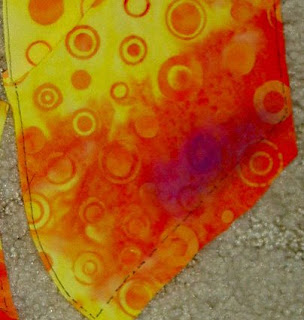Last week was a hard week, which culminated with me having to drive 3 hours north on Friday to go on a short vacation with my family. part of me wanted to go and part of me wanted to lay face down in my own bed all weekend. I wasn’t looking forward to the drive and was tight as a spring up until I got out of the City. I finally got to the lake and the first thing I did was look up quilt shops. The weather was not laying by the pool weather and I was determined to have some fun.There are two shops in the area I was willing to drive in: Shelley’s Quilted Treasures and Kerri’s Quilting.
The first shop I found and visited was in Kelseyville. Kelseyville is a small town with a main street that is pretty lively. There was an antique store, a bead store, a computer store, and a couple of restaurants in addition to Shelley’s Quilted Treasures. We also passed the public library on our way there.
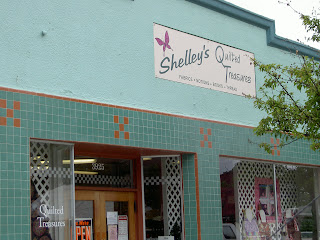
The shop has been there for 12 years, but Shelley has only owned it for about 2.5 years. Brenda manages the shop and is knowledgeable ( I heard her helping someone select the right amount of fabric for a class project) and VERY friendly.
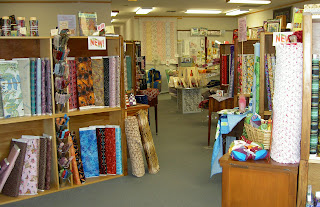 The store is large, bright and very cheerful. There were at least three other rooms behind the sales floor, one of which housed a longarm machine. The fabrics were fun, on the new side and who couldn’t love four shelves of dots? I found one of the Basix dots and bought the rest of the bolt. They had a lot of very appealing kits, including one with the above referenced Basix dot print and turquoise in a rail fence pattern. Normally, I am a bit dismissive of kits (the snob in me, I guess), because they appear to require so little thought. However, a combination of the Gabrielle Swain class and going to Shelley’s as well as the experience I had in a quilt shop with the woman who had finished all of the quilts in Quilts Quilts Quilts made me realize that not everyone knows how to design a quilt; not even putting blocks together with confidence. I don’t think it is most people, but I do think that a lot of people don’t have the confidence to try and fail. I think also there is an issue with “wasting” fabric.
The store is large, bright and very cheerful. There were at least three other rooms behind the sales floor, one of which housed a longarm machine. The fabrics were fun, on the new side and who couldn’t love four shelves of dots? I found one of the Basix dots and bought the rest of the bolt. They had a lot of very appealing kits, including one with the above referenced Basix dot print and turquoise in a rail fence pattern. Normally, I am a bit dismissive of kits (the snob in me, I guess), because they appear to require so little thought. However, a combination of the Gabrielle Swain class and going to Shelley’s as well as the experience I had in a quilt shop with the woman who had finished all of the quilts in Quilts Quilts Quilts made me realize that not everyone knows how to design a quilt; not even putting blocks together with confidence. I don’t think it is most people, but I do think that a lot of people don’t have the confidence to try and fail. I think also there is an issue with “wasting” fabric.
The shop also had a great collection of pear pincushions. They had ready made pincushions for about $20 and patterns so you could make your own. I thought about buying one, but didn’t see one with a fabric combination I adored.
I found out later that Lake County used to be renowned for its pear crop, but that all of the pear trees are being replaced with vineyards.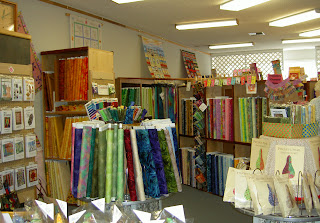 The shop was light and airy with dark-ish brown shelves. they had a lot of new fabrics, but some golden oldies as well ( like the Basix). Shelley’s stocked other materials as well such as Tsukineko Fabric pens, a holder for my colored pencils, which I bought since I had been fighting with the organization of my colored pencils the day before.
The shop was light and airy with dark-ish brown shelves. they had a lot of new fabrics, but some golden oldies as well ( like the Basix). Shelley’s stocked other materials as well such as Tsukineko Fabric pens, a holder for my colored pencils, which I bought since I had been fighting with the organization of my colored pencils the day before.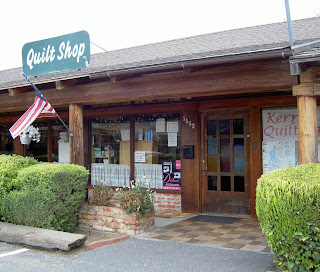 Next, we drove to Lakeport. I had my MIL and SIL along who were very patient and didn’t hurry me along. We missed the Lakeport Memorial Day Parade, but stopped at Kerri’s Quilting, which is a nice little shop in a sad location. We were the only people visiting at the time. It is a small shop, but has a really nice fabric. I found a couple of dots and some 40s (??) pinwheel fabric in a different colorway than I had before. I saw an Artbin that held 12″ projects, but forgot to buy one. The owner was friendly and showed me the little sundresses she was making for her granddaughter. She had also juste received a small business award from the city.
Next, we drove to Lakeport. I had my MIL and SIL along who were very patient and didn’t hurry me along. We missed the Lakeport Memorial Day Parade, but stopped at Kerri’s Quilting, which is a nice little shop in a sad location. We were the only people visiting at the time. It is a small shop, but has a really nice fabric. I found a couple of dots and some 40s (??) pinwheel fabric in a different colorway than I had before. I saw an Artbin that held 12″ projects, but forgot to buy one. The owner was friendly and showed me the little sundresses she was making for her granddaughter. She had also juste received a small business award from the city.
The mall where Kerri’s resides has a lot of vacancies, including a restaurant space and the anchor space, which used to be a market, and is located behind an old, decrepit and defunct gas station. Lakeport looks like a nice town (larger than Kelseyville).
I hope that the day we were there was a slow day and that normally the shop is bustling.
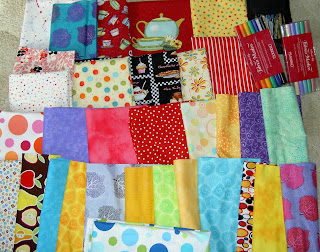 These are my weekend purchases.
These are my weekend purchases.
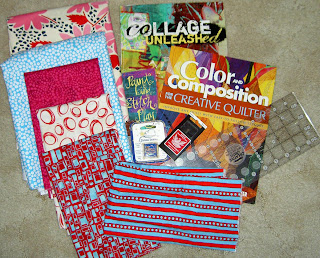
These are the purchases I made after the Gabrielle Swain class at New Pieces in Berkeley. The books were very spur of the moment.
